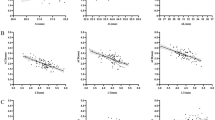Abstract
Purpose
To investigate the relationship between relative lens position (RLP) and appositional closure in eyes with narrow angles.
Methods
Ultrasound biomicroscopy (UBM) was used to measure anterior chamber depth (ACD) and lens thickness (LT), and the IOLMaster to measure axial length (AL). The number of quadrants with appositional closure was assessed by UBM under dark conditions. The RLP was calculated thus: RLP = 10 × (ACD + 0.5 LT) /AL.
Results
This study comprised 30 consecutive patients (30 eyes) with narrow-angle eyes defined as Shaffer grade 2 or lower and without peripheral anterior synechiae (24 women, 6 men; mean age ± SD, 67.3 ± 10.4 years; range, 42–87 years). Under dark conditions, 66.7% of the eyes with narrow angles showed appositional closure in at least one quadrant. Of the various ocular biometric parameters, only the RLP significantly decreased with appositional closure in at least one quadrant (P = 0.005).
Conclusion
A decrease in the RLP can be predictive of appositional closure for narrow-angle eyes under dark conditions.
Similar content being viewed by others
References
Amerasinghe N, Aung T. Angle-closure: risk factors, diagnosis and treatment. Prog Brain Res 2008;173:31–45.
Kumar RS, Tantisevi V, Wong MH, et al. Plateau iris in Asian subjects with primary angle closure glaucoma. Arch Ophthalmol 2009;127:1269–1272.
Devereux JG, Foster PJ, Baasanhu J, et al. Anterior chamber depth measurement as a screening tool for primary angle-closure glaucoma in an East Asian population. Arch Ophthalmol 2000;118: 257–263.
Saxena S, Agawal PK, Pratap VB, et al. The predictive value of the relative lens position in primary angle-closure glaucoma. Ann Ophthalmol 1993;12:453–456.
Sakuma T, Sawada A, Yamamoto T, et al. Appositional angleclosure in eyes with narrow angles: an ultrasound biomicroscopic study. J Glaucoma 1997;6:165–169.
Ishikawa H, Esaki K, Liebmann JM, et al. Ultrasound biomicroscopy dark room provocative testing: a quantitative method for estimating anterior chamber angle width. Jpn J Ophthalmol 1999; 43:562–534.
Kunimatsu S, Tomidokoro A, Mishima K, et al. Prevalence of appositional angle closure determined by ultrasound biomicroscopy in eyes with shallow anterior chamber. Ophthalmology 2005;112: 407–412.
Barkana Y, Dorairaj SK, Gerber Y, et al. Agreement between gonioscopy and ultrasound biomicroscopy in detecting iridotrabecular apposition. Arch Ophthalmol 2007;125:1331–1335.
Lowe RF. Aetiology of the anatomical basis for primary angleclosure glaucoma: biometric comparisons between normal eyes and eyes with primary angle-closure glaucoma. Br J Ophthalmol 1970;54:161–169.
Yao BQ, Wu LL, Zhang C, et al. Ultrasound biomicroscopic features associated with angle closure in fellow eyes of acute primary angle closure after laser iridotomy. Ophthalmology 2009;116:444–448.
Marchini G, Pagliarusco A, Toscano A, et al. Ultrasound biomicroscopic and conventional ultrasonographic study of ocular dimensions in primary angle-closure glaucoma. Ophthalmology 1998;105: 2091–2098.
Xu L, CAO WF, Wang YX, et al. Anterior chamber depth and chamber angle and their associations with ocular and general parameters: The Beijing Eye Study. Am J Ophthalmol 2008;145: 929–936.
George R, Paul PG, Baskaran M, et al. Ocular biometry in occludable angles and angle closure glaucoma: a population based survey. Br J Ophthalmol 2003;87:399–402.
Thomas R, George R, Parikh R, et al. Five year risk of progression of primary angle closure suspects to primary angle closure: a population based study. Br J Ophthalmol 2003;87:450–454.
Lan Y-W, Hsieh J-W, Hung P-T. Ocular biometry in acute and chronic angle-closure glaucoma. Ophthalmologica 2007;221:388–394.
Buckhurst PJ, Wolffsohn JS, Shah S, et al. A new optical low coherence reflectometry device for ocular biometry in cataract patients. Br J Ophthalmol 2009;93:949–953.
Author information
Authors and Affiliations
Corresponding author
About this article
Cite this article
Otori, Y., Tomita, Y., Hamamoto, A. et al. Relationship between relative lens position and appositional closure in eyes with narrow angles. Jpn J Ophthalmol 55, 103–106 (2011). https://doi.org/10.1007/s10384-010-0918-6
Received:
Accepted:
Published:
Issue Date:
DOI: https://doi.org/10.1007/s10384-010-0918-6




